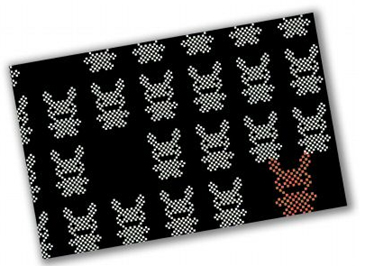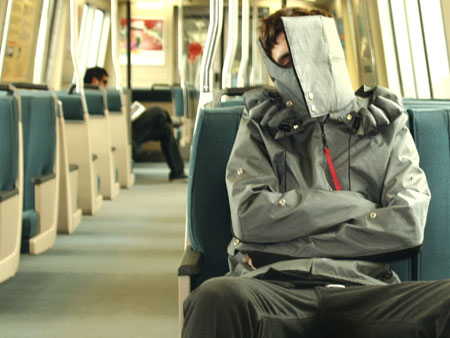You walk into a small barbershop. There's a transistor radio going with some oldies and a soundless sports game going on a small television. Copyright infringement? Under the Copyright Act's "homestyle" exception found at Section 110(5)(A), your barber's probably safe.
You own a commercial establishment, like a truck stop. Instead of playing the commercials supplied by ABC, you install an electronic sensor that detects the advertisements, and inserts your advertisements instead of ABC's. Does ABC have the "right to sell and append commercial advertising to the beginning, middle or end of a film, news show, sitcom, sporting event, or other program that is shown on television
whether or not [ABC] own[s] the copyrights in those shows?"A recent decision by Judge Deborah Batts explores the "homestyle exception" embodied in 17 U.S.C. 110(5)(A) and (B).
American Broadcasting Companies, Inc. v. Flying J, 2007 WL 583176 (S.D.N.Y.). Section 110 is titled: "Limitations on exclusive rights: Exemption of certain performances and displays". To figure out whether the establishment is exempt, you need to read both sections "A" and "B" of the statute to see whether the establishment is small enough to qualify. Congress intended to "allow the use of ordinary radios and television sets for the incidental use of patrons in small businesses or other professional establishments, such as taverns, lunch counters, dry cleaners, doctors' office, etc."
Notwithstanding the provisions of section
106, the following are not infringements of copyright:
(5)
(A) except as provided in subparagraph (B), communication of a transmission embodying a performance or display of a work by the public reception of the transmission on a single receiving apparatus of a kind commonly used in private homes, unless—
(i) a direct charge is made to see or hear the transmission; or
(ii) the transmission thus received is further transmitted to the public;
(B) communication by an establishment of a transmission or retransmission embodying a performance or display of a nondramatic musical work intended to be received by the general public, originated by a radio or television broadcast station licensed as such by the Federal Communications Commission, or, if an audiovisual transmission, by a cable system or satellite carrier, if—
(i) in the case of an establishment other than a food service or drinking establishment, either the establishment in which the communication occurs has less than 2,000 gross square feet of space (excluding space used for customer parking and for no other purpose), or the establishment in which the communication occurs has 2,000 or more gross square feet of space (excluding space used for customer parking and for no other purpose) and—
(I) if the performance is by audio means only, the performance is communicated by means of a total of not more than 6 loudspeakers, of which not more than 4 loudspeakers are located in any 1 room or adjoining outdoor space; or
(II) if the performance or display is by audiovisual means, any visual portion of the performance or display is communicated by means of a total of not more than 4 audiovisual devices, of which not more than 1 audiovisual device is located in any 1 room, and no such audiovisual device has a diagonal screen size greater than 55 inches, and any audio portion of the performance or display is communicated by means of a total of not more than 6 loudspeakers, of which not more than 4 loudspeakers are located in any 1 room or adjoining outdoor space;
(ii) in the case of a food service or drinking establishment, either the establishment in which the communication occurs has less than 3,750 gross square feet of space (excluding space used for customer parking and for no other purpose), or the establishment in which the communication occurs has 3,750 gross square feet of space or more (excluding space used for customer parking and for no other purpose) and—
(I) if the performance is by audio means only, the performance is communicated by means of a total of not more than 6 loudspeakers, of which not more than 4 loudspeakers are located in any 1 room or adjoining outdoor space; or
(II) if the performance or display is by audiovisual means, any visual portion of the performance or display is communicated by means of a total of not more than 4 audiovisual devices, of which not more than one audiovisual device is located in any 1 room, and no such audiovisual device has a diagonal screen size greater than 55 inches, and any audio portion of the performance or display is communicated by means of a total of not more than 6 loudspeakers, of which not more than 4 loudspeakers are located in any 1 room or adjoining outdoor space;
(iii) no direct charge is made to see or hear the transmission or retransmission;
(iv) the transmission or retransmission is not further transmitted beyond the establishment where it is received; and
(v) the transmission or retransmission is licensed by the copyright owner of the work so publicly performed or displayed
In
ABC v. Flying J, Judge Batts found that the owner of 130 truck stops infringed Plaintiff's copyrights by showing network programming downloaded from a satellite dish and using an apparatus to remove and replace the commercials. The court dismissed the unfair competition claim based on New York law as being preempted by the Copyright Act, 17 U.S.C. 301. The court found that the mere display of the television programming at the truck stops probably fell within section 110's homestyle exception. However, the court's copyright infringement analysis was based mainly on the fact that the brand new commercial technology to remove and replace advertisements did not qualify for the homestyle exception.
What sort of right exists in the spaces filled with advertising before, during and after television transmissions was not reached by the court, but the court made clear that the answer was to be found in the Copyright Act, rather than under state law.
Practice Tip: To get a good decision protecting the empty spaces before during and after their copyrighted programming, television industry plaintiffs may need the cooperation of advertisers who own the copyrights in the advertisements to ensure that they have standing in their next lawsuit against a defendant cutting out paid advertisements.






 Three men have been arrested in connection with the July 7 London bombings
Three men have been arrested in connection with the July 7 London bombings




















